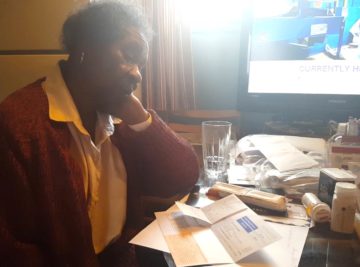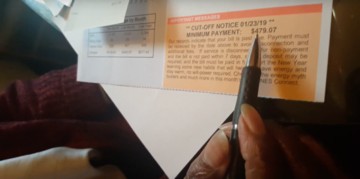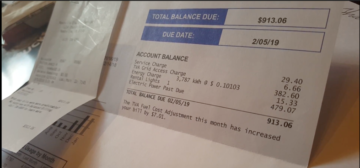This blog post was written by Jason Carney, former Clean Energy Program Manager with the Southern Alliance for Clean Energy. This posting, which is part of SACE's series 'Putting a Face on Energy Burden,' tells the story of Annie Pearl Patton, a Nashville resident suffering high energy burden outside of her control.
Guest Blog | March 14, 2019 | Energy Justice, Tennessee, Utilities
You can read personal stories sharing disproportionate energy burden in Memphis here and in Knoxville here.
High electric bills are the norm for retired librarian Annie Pearl Patton. “I am a widow and can’t pay bills like this.”
Unfortunately, Mrs. Patton isn’t alone. Many of Nashville’s senior citizens live in aging homes and face the painful reality of unrealistically high electric bills without any recourse.
IS HELP ON THE WAY?
As I sat in Annie Patton’s Nashville kitchen on February 27 to look at her most recent electric bill from Nashville Electric Service (NES), one of the first things we noticed was the boldfaced total due at over $900, made up of a past due amount of $400+ in addition to the current month’s charges. Another aspect of the bill that immediately drew our attention was the Cutoff Notice, brightly colored at the bottom of the bill, explaining that the energy Mrs. Patton uses to heat her home would be disconnected if she did not remit payment.

Mrs. Patton is victim of an aging home with a broken HVAC system. She can’t afford a brand new one on a fixed income. Although she’s been approved for assistance from NES through their Home Energy Uplift program, they told her that due to backlog, it would be months before a contractor could reach her. She is now using window A/C units and space heaters, furthering the cycle of high bills. This, combined with repeating and ever-increasing fixed fees, has created a situation in which her skyrocketing bills are a constant threat to her safety and security. Inefficient homes are inherently subject to higher electric bills, especially in the wintertime when heat is a necessity; and customers living in old, drafty homes, like Mrs. Patton, often find themselves facing impossibly high bills, even though they keep their thermostats at uncomfortable temperatures in an effort to conserve.
This is clearly the case in Annie Patton’s home. After reflecting on the recent winter months, and considering the amount she owed NES, she concluded: “In this house, as cold as I was, I shouldn’t be charged this much.”
ANALYSIS PARALYSIS

Less noticeable, in smaller print, and almost hidden within the lines of the bill, are the listed line items that make up Mrs. Patton’s bill. Each month, in addition to her usage fees, Annie Patton is charged around $36 in fixed fees, ambiguously referred to as “Service Charge” ($29.40/month) and “TVA Grid Access Charge” ($6.66/month). These fixed fees appear on every NES bill, and while they may seem small, they add up, especially in the homes of those who can’t afford repair as homes age or can’t afford the quality homes typically built in more affluent neighborhoods.
At the current rates, customers pay nearly $450 per year in fixed fees before they even begin to pay for the electricity they actually use. Like most customers, Annie Patton doesn’t know where to start in understanding fixed charges, and therefore doesn’t feel empowered to control her energy costs. She says, “They should call me and let me come into their office and explain to me what these charges are. Because I don’t know what they are.” Like many customers, when trying to decipher her monthly bills, she is essentially paralyzed by the confusing ways the charges are presented, and eventually gives up, thinking there is nothing she can do anyway. This lack of understanding and agency allows utilities to impose fixed fees and change rates without any real threat of public outrage.
THE CASE AGAINST MONOPOLY POWER: HIGH BILLS

The Tennessee Valley Authority (TVA) makes virtually all of the electricity for Tennesseans, and sends it out to customers via its 150+ different distributors throughout the state. These distributors include the “Big Four:” NES, Memphis Light Gas and Water (MLGW), Knoxville Utility Board (KUB), and the Electric Power Board (EPB) in Chattanooga, in addition to smaller local companies. These distributor companies each have individual autonomy in how their customers’ bills are structured.
TVA routinely touts a statistic claiming that their electricity rates are ranked 8th lowest in the nation. While this may be true, Tennesseans’ electricity bills are in the top 10 highest bills in the nation, according to a report by the Union of Concerned Scientists. African-Americans bear the brunt of this burden as over 50% of this frontline community struggle with paying electric bills.
Mrs. Patton kept her lights and heat on by refinancing her home, going into further debt. Customers, especially those making every effort to keep their bills low, for instance, by living in homes that they heat insufficiently in the cold months, should never have to go into debt to pay energy bills. Furthermore, many do not even have the option to take advantage of this less-than-ideal solution. Without sustainable actions for the short and long term, frontline communities experiencing high bills all over Nashville will continue to have the arduous task of deciding what must be sacrificed to keep the heat and lights on.
THERE HAS TO BE A BETTER WAY

As described above, the major culprits contributing to Tennessee’s low rates / high bills phenomenon are the same ones that are constantly threatening Mrs. Patton: poor housing stock (inefficient homes have higher energy usage), and exorbitant fixed fees. In order to give immediate relief to our most vulnerable citizens in Tennessee, we need to address these two issues simultaneously.
One of the most immediate way to provide relief is by reaching for low-hanging fruit through programs that address housing stock (i.e. cutting usage by fixing up homes). MLGW and KUB, two of Tennessee’s “Big Four” utilities (and some smaller co-ops) have adopted sustainably funded programs to address usage. NES, TVA’s second largest customer, has not. Last month, Nashville council members had an opportunity to make this a priority through a resolution called “Round-It-Up” that would encourage NES to round up bills to the nearest dollar, to allow those who are willing to donate, on average, $6 per year toward weatherizing the homes of low-income, vulnerable residents like Mrs. Patton. Unfortunately, after much misinformation, during over an hour of commentary, the Council chose not to vote on the non-binding, opt-out resolution, even after about 50 supporters showed up to the Council meeting with no visible detractors in attendance.
NES should join its peer cities in adopting this program, but management has currently decided not to take it to their Board. This decision is detached from – and out of touch with – the needs of Nashvillians who need these programs the most; especially in the colder months.
In addition to programs to address usage, SACE also supports efforts to advance weatherization and improved efficiency that can provide relief to vulnerable customers like Annie Patton, and we are working throughout Tennessee to reject billing plans with high fixed fees at TVA distributor utilities. If you share our desire to promote a more equitable energy system, please sign up to receive notices so you can stay informed or join with supporters in our next action.